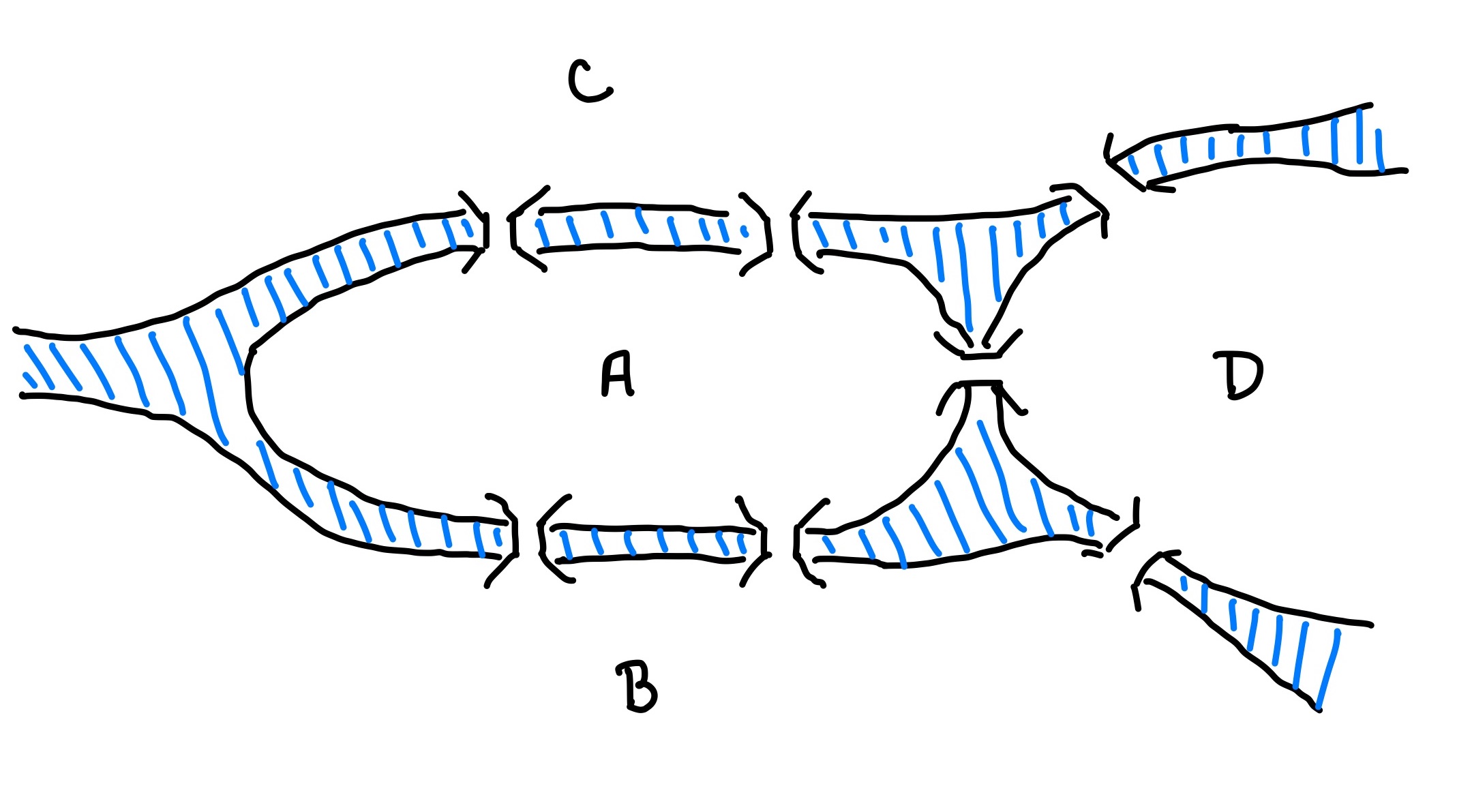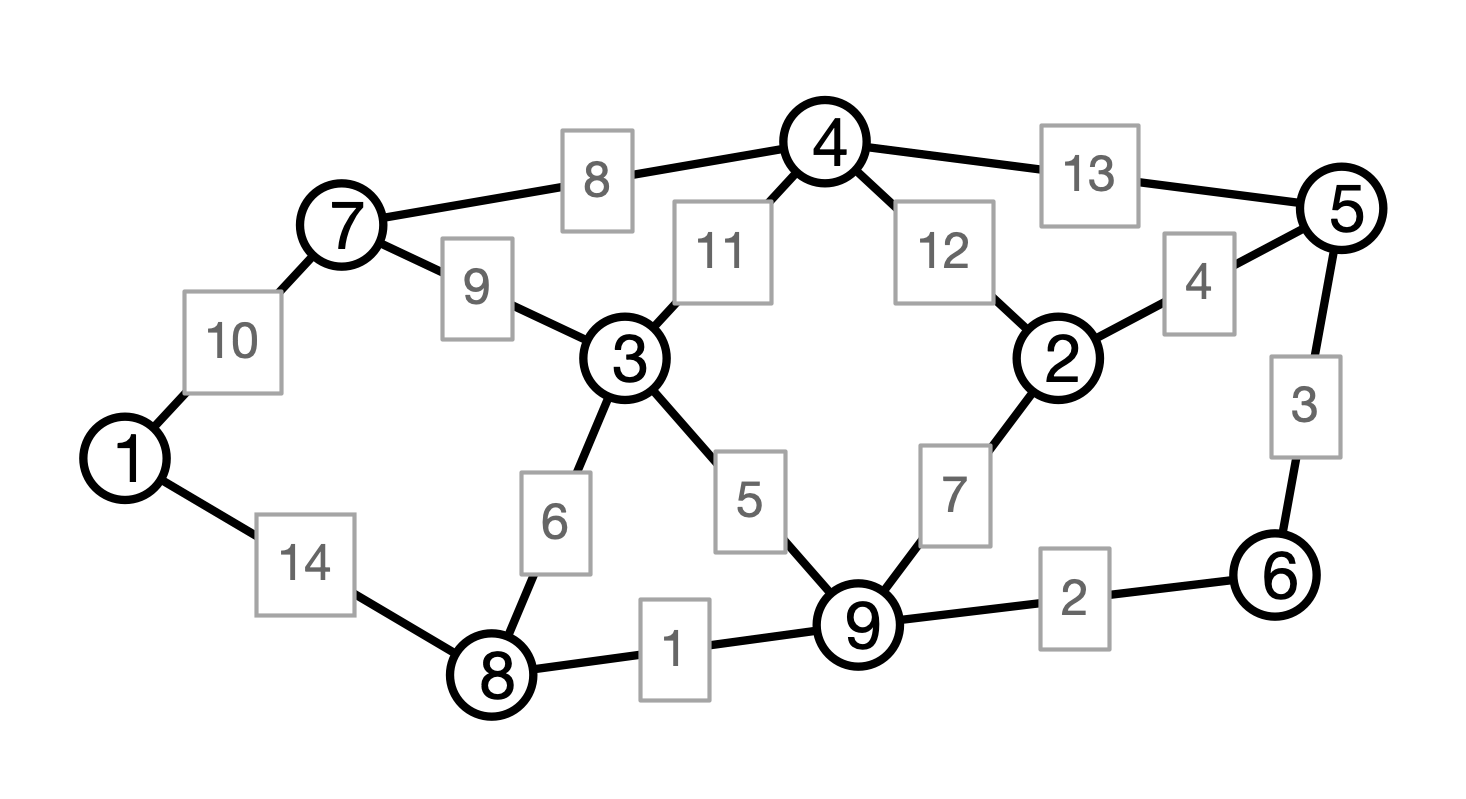Lecture 18: Minimum Spanning Trees
COSC 311 Algorithms, Fall 2022
$ \def\compare{ {\mathrm{compare}} } \def\swap{ {\mathrm{swap}} } \def\sort{ {\mathrm{sort}} } \def\insert{ {\mathrm{insert}} } \def\true{ {\mathrm{true}} } \def\false{ {\mathrm{false}} } \def\BubbleSort{ {\mathrm{BubbleSort}} } \def\SelectionSort{ {\mathrm{SelectionSort}} } \def\Merge{ {\mathrm{Merge}} } \def\MergeSort{ {\mathrm{MergeSort}} } \def\QuickSort{ {\mathrm{QuickSort}} } \def\Split{ {\mathrm{Split}} } \def\Multiply{ {\mathrm{Multiply}} } \def\Add{ {\mathrm{Add}} } \def\cur{ {\mathrm{cur}} } \def\gets{ {\leftarrow} } $
Announcements
- Midterms
- should finish grading tomorrow
- pick up in class Wednesday or OH on Thursday
- No class on Monday 10/24
- reading + recorded lecture instead
Overview
- Minimum Spanning Tree Problem
- Prim’s Algorithm
Last Time: Dijkstra’s Algorithm
Single Source Shortest Paths
-
Input
- graph $G = (V, E)$
- edge weights/lengths $w$
- starting vertex $u$
-
Output
- (weighted) distance $d[v] = d_w(u, v)$ for every vertex $v$
Dijkstra’s Algorithm:
- maintain set $S$ of finalized nodes
-
greedily choose $v \in V - S$ with minimum $d[v]$
- finalize $v$
- update $d[x]$ for each neighbor $x$ of $v$
DPW in Königsberg
Winter is coming to Königsberg!
- Must prepare the bridges for ice
- Each bridge has an associated cost to de-ice
- Königsberg doesn’t have the budget to de-ice all bridges
- For public safety, must ensure that all landmasses are reachable from each other
Question. How to find the cheapest set of bridges to de-ice that maintain connectivity?
Picture

Graph Problem
Input:
- a weighted graph $G = (V, E)$ with edge weights $w$
Output:
-
a set $F$ of edges in $E$ such that
- $(V, F)$ is connected
- sum of weights of edges in $F$ is minimal among all connected sub-graphs of $G$
The graph $T = (V, F)$ is called a minimum spanning tree of $G$
Example

Trees
Recall. A tree $T$ is a graph that:
- is connected, and
- contains no cycles
MST Problem
Input:
- a weighted graph $G = (V, E)$ with edge weights $w$
Output:
-
a set $F$ of edges in $E$ such that
- $(V, F)$ is connected
- sum of weights of edges in $F$ is minimal among all connected sub-graphs of $G$
Question. Why must $T = (V, F)$ be a tree?
A Claim
Claim. Suppose $T$ is an MST for a weighted graph $G$. Then $T$ is a tree.
Proof. Argue by contradiction.
- Suppose $T$ is not a tree
- By definition of MST, $T$ is connected
- So $T$ must contain a cycle $C$
- Removing any edge $e$ from $C$ results in a smaller spanning “tree”
- $\implies T$ was not minimal, a contradiction
An Idea
Grow a tree outward from a seed vertex:
- start with $u$
- repeat until we get a spanning tree:
- pick a new edge $e$ to add to our tree
Question. How should we pick the “next” edge?
Tree Growing Example

Question
What information do we need to maintain in order to implement this procedure?
Prim’s Algorithm
PrimMST(V, E):
initialize set S = {v} with v arbitrary
initialize set F = {} of MST edges, priority queue Q
for each neighbor x of v
add (v, x) to Q with priority w(v, x)
while Q is not empty
(u, v) <- removeMin(Q)
if S doesn't contain v
add (u, v) to F
for each neighbor x of v
add (v, x) to Q with priority w(v, x)
return (S, F)
Prim Illustration

Question
Why is graph returned by Prim a tree?
PrimMST(V, E):
initialize set S = {v} with v arbitrary
initialize set F = {} of MST edges, priority queue Q
for each neighbor x of v
add (v, x) to Q with priority w(v, x)
while Q is not empty
(u, v) <- removeMin(Q)
if S doesn't contain v
add (u, v) to F
for each neighbor x of v
add (v, x) to Q with priority w(v, x)
return (S, F)
Another Question
Why is graph returned by Prim a MST?
- assume all edge weights are distinct
Must show. Every edge added to $F$ is in an MST.
Cuts in Graphs
Definition. Let $G = (V, E)$ be a graph. A cut in $G$ is a partition of $V$ into two (non-empty) subsets $U$ and $V - U$.

Cuts and MSTs
Cut Claim. Suppose:
- $G = (V, E)$ is a weighted graph (with distinct edge weights)
- $U, V - U$ a cut in $G$
- $T = (V, F)$ an MST
- $e = (u, v)$ is the minimum weight edge that crosses the cut
- $u \in U$ and $v \in V - U$
Then:
- $T$ contains the edge $e$
Cut Claim Illustration

Prim, Again
PrimMST(V, E):
initialize set S = {v} with v arbitrary
initialize set F = {} of MST edges, priority queue Q
for each neighbor x of v
add (v, x) to Q with priority w(v, x)
while Q is not empty
(u, v) <- removeMin(Q)
if S doesn't contain v
add (u, v) to F
for each neighbor x of v
add (v, x) to Q with priority w(v, x)
return (S, F)
Prim Correctness I
Cut claim $\implies$ Prim produces an MST.
Why?
Consider $k$th edge $e_k$ added by Prim
- $S_k = $ contents of $S$ before edge added
What can we say about the cut $S_k, V - S_k$?
Prim Correctness II
First Conclusion. Every edge $e$ added by Prim’s algorithm is in the MST.
Still to show. All MST edges are added.
Why is this so?
- Suffices to argue that Prim produces a spanning tree
- Set of edges found by Prim form a tree
- All vertices of $V$ are in tree (if $G$ is connected)
Conclusion. Prim’s algorithm produces an MST.
Prim Running Time?
PrimMST(V, E):
initialize set S = {v} with v arbitrary
initialize set F = {} of MST edges, priority queue Q
for each neighbor x of v
add (v, x) to Q with priority w(v, x)
while Q is not empty
(u, v) <- removeMin(Q)
if S doesn't contain v
add (u, v) to F
for each neighbor x of v
add (v, x) to Q with priority w(v, x)
return (S, F)
Conclusion
Prim’s algorithm:
- computes an MST in $G$
- if efficient priority queue is used, running time is $O(m \log n)$
Prim’s algorithm is greedy
- to grow a tree, always add the lightest outgoing edge
Next Time
Another greedy MST algorithm!